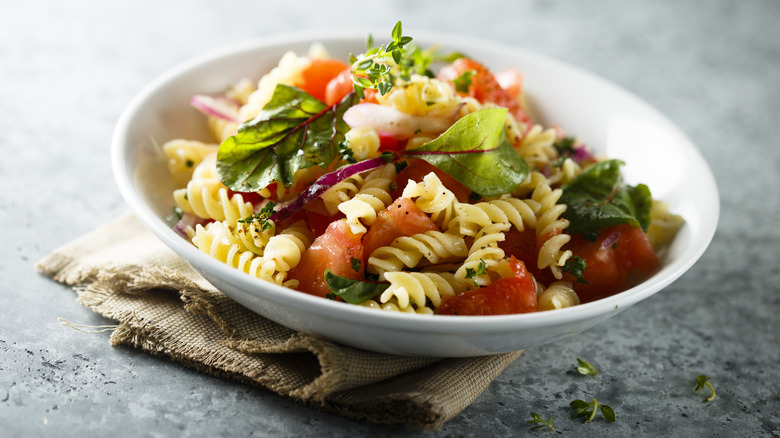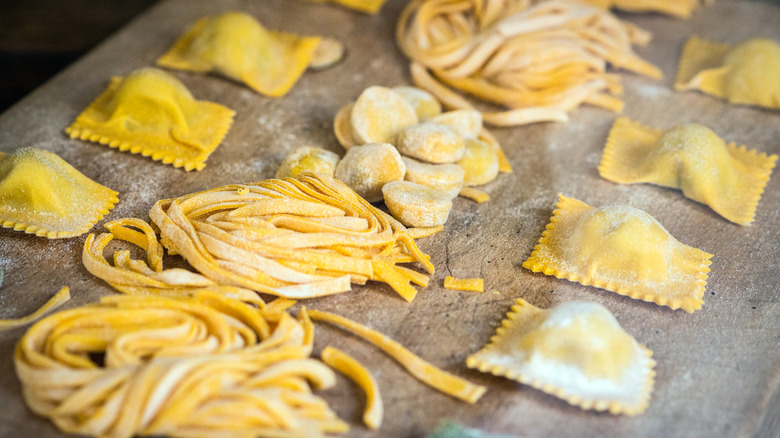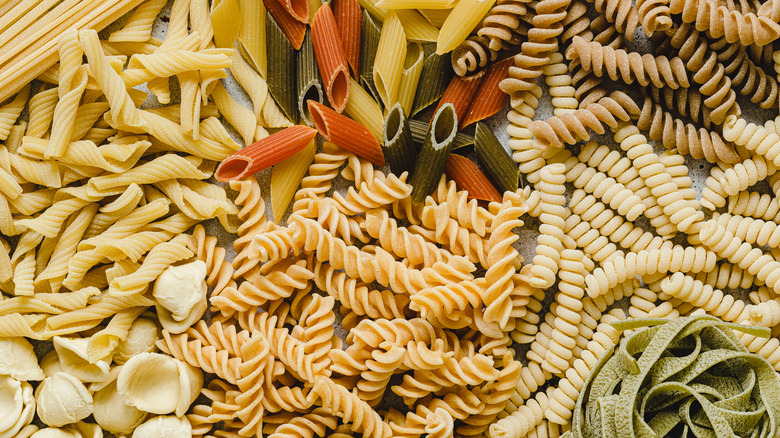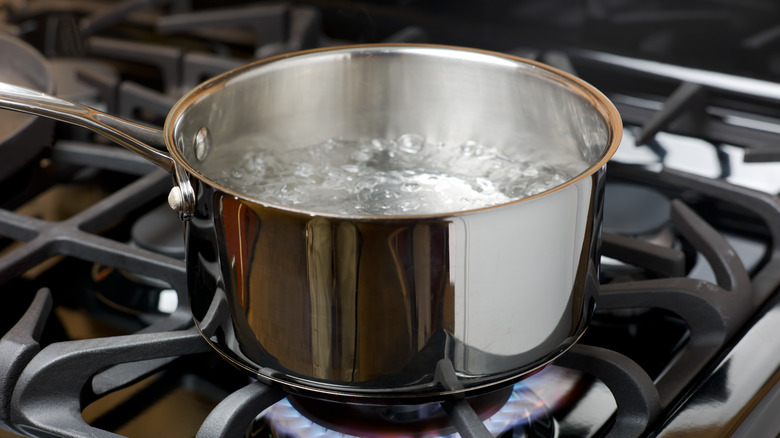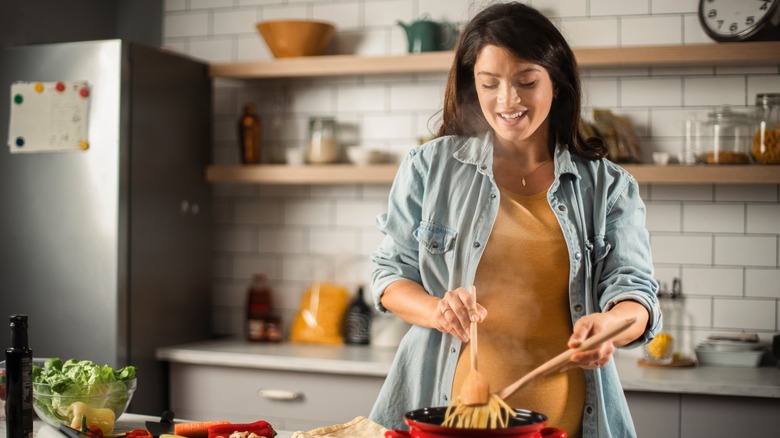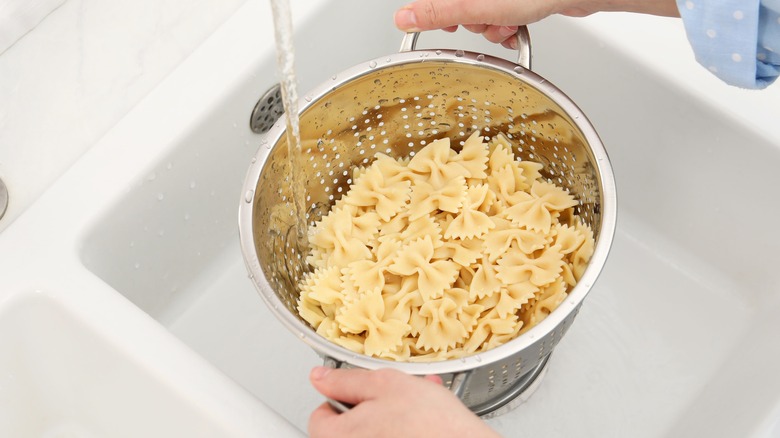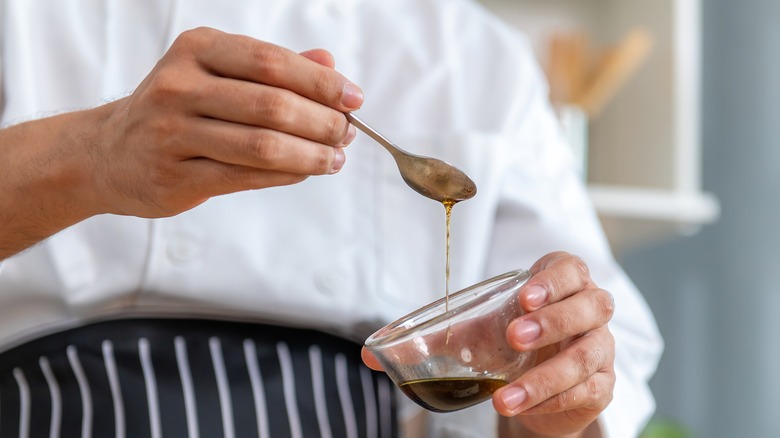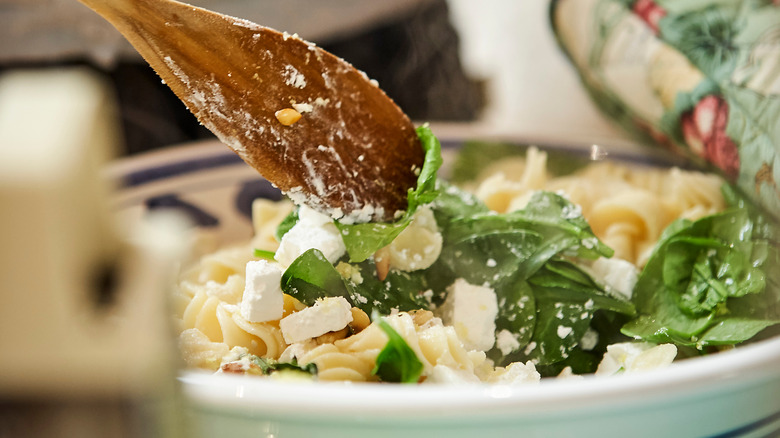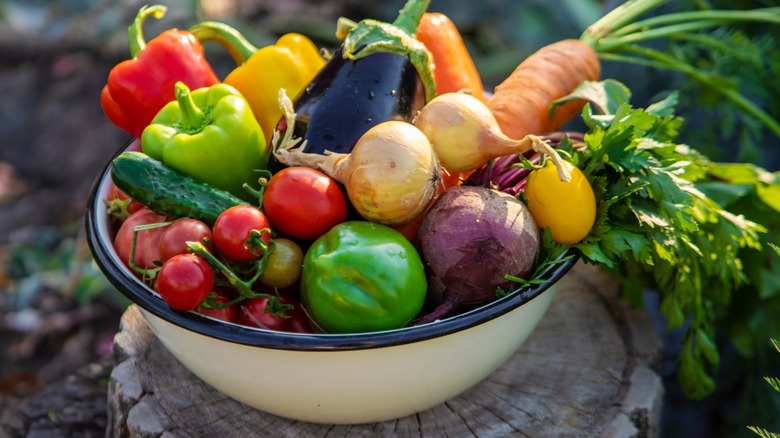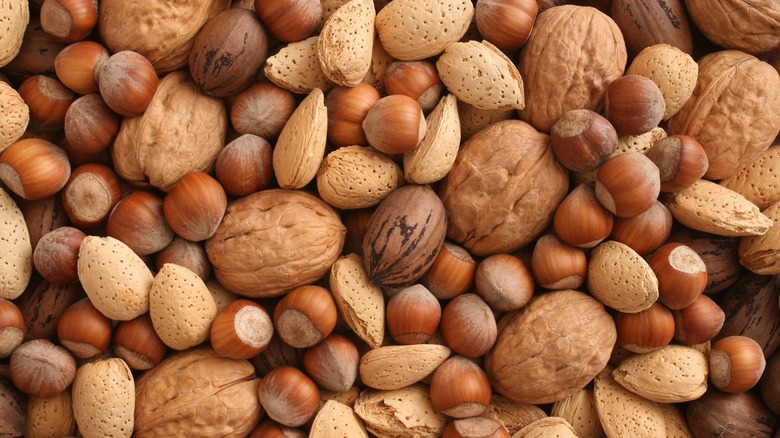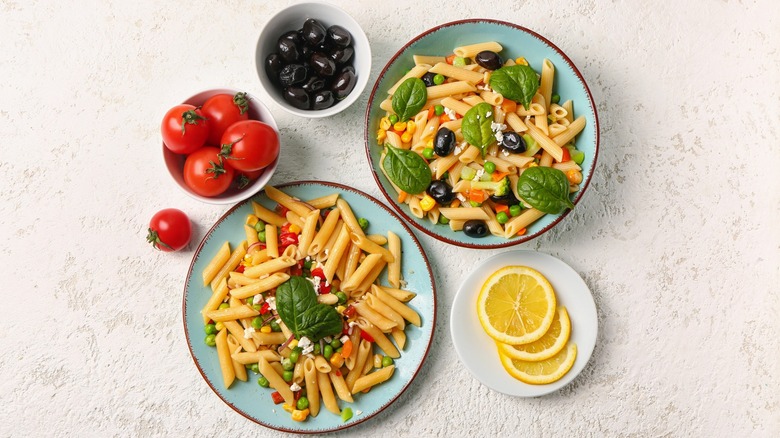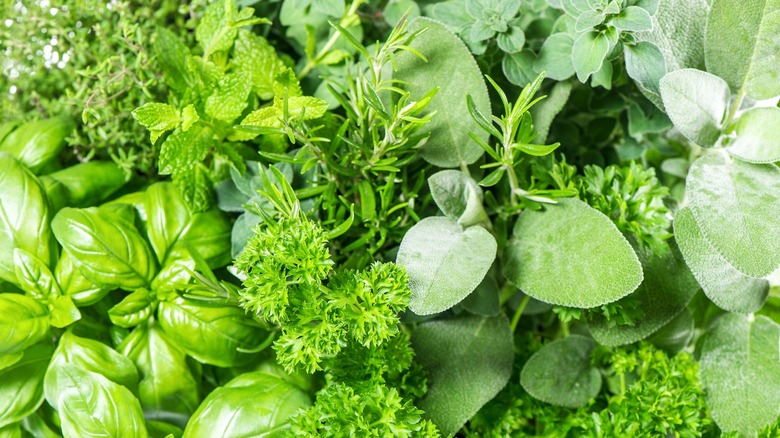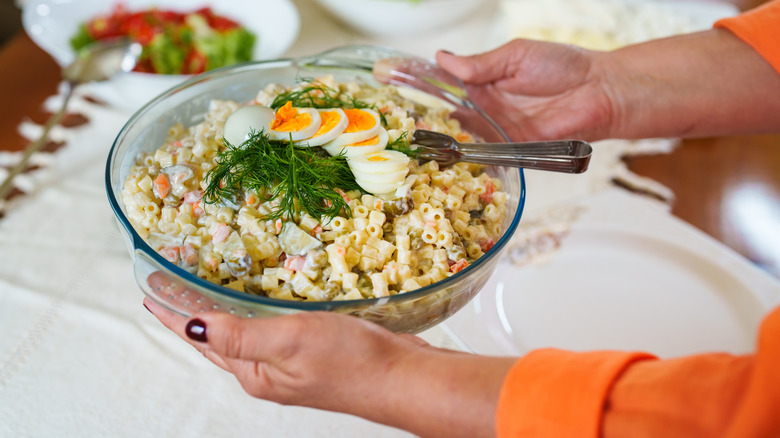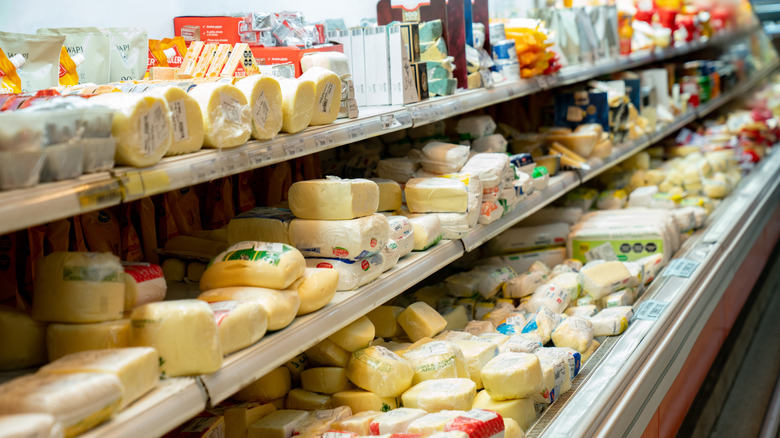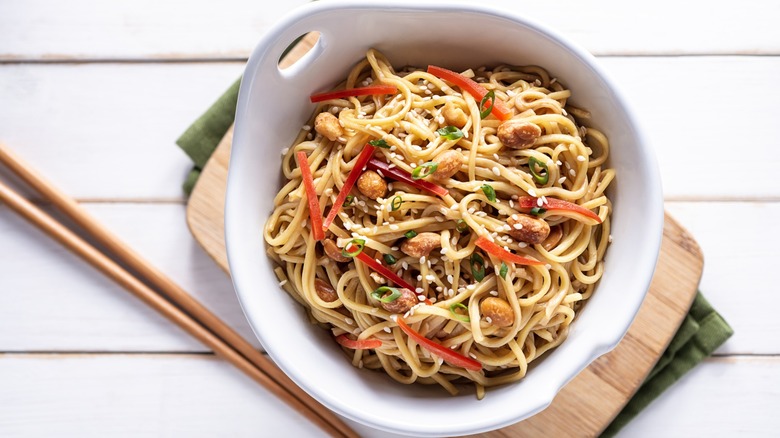Mistakes Everyone Makes With Pasta Salad
Pasta salad is a mainstay of barbecues, potlucks, and summer picnics. Made correctly, pasta salad recipes are tangy, durable, and suitable for batch cooking, so you can serve a crowd with them or put them in the fridge to eat for days. Even the most delicate pasta salad ingredients should last a few hours at the very least, meaning you can safely prepare your salad ahead of time.
Plus, there are many ways to prepare pasta salad. You can make an Italian pasta salad filled with mozzarella and deli meats, or a Greek pasta salad dotted with Kalamata olives and feta cheese. Many pasta salad recipes also work well with winter veggies like kale and broccoli, as well as summer veggies like tomatoes and cucumbers. The variations truly have no end.
Unfortunately, there's also no end to the mistakes you can make with pasta salad, either. From choosing the wrong noodle type to cooking it incorrectly to mishandling your ingredients, home chefs all too often face the disappointment of weird, mushy, or just plain boring pasta salads. If you're ready to avoid these fates, this guide is here to help.
Using fresh pasta
First and foremost, you should only use dried pasta for pasta salad. Fresh pasta — while tender and delicious for hot dishes covered in sauce — doesn't work that well in pasta salad. This is because it's so succulent, so it breaks down more quickly than dried pasta does once cooked and dressed. Dried pasta is much more durable, due to the manufacturing process it undergoes before it hits shelves; it's usually dehydrated and hardened for a few hours to a few days. For these reasons, always choose dry pasta if you're making pasta salad.
The exception to this is warm pasta salad, which you're going to eat right away. This is essentially just pasta proper, since it doesn't have to face the same rigors of cooling and standing in the fridge. In this case, it's probably safe to experiment with fresh noodles. Just make sure to look up warm pasta salad recipes and prepare them according to their instructions.
Choosing the wrong pasta shape
It turns out that pasta salad recipes are kind of fussy about pasta shape. While you might think that noodles of any kind could work, that's not the case. While longer pasta shapes, such as fettuccine and spaghetti, are enjoyable at dinner time, they make for a frustrating pasta salad experience. The sauce and other ingredients don't stick to them as well, and it's more difficult to wrangle long noodles when they're cold.
The best pasta shapes for cold salads have lots of little grooves, divots, nooks, and crannies to snag other pasta salad ingredients and hold onto them. Choose shapes such as fusilli, tortellini, or farfalle (otherwise known as bowtie pasta), all of which are relatively bite-sized and have shapes that will hold things in. Macaroni, penne, and cavatappi are also fun options to use. If you want a very delicate effect in your pasta salad, you can also opt for orzo or couscous. While many people believe the latter to be a type of grain, it's actually a small traditional pasta made from semolina flour and hailing from the Middle East.
Forgetting to salt the pasta water
You might assume that you don't need to salt your pasta water since you're going to put a flavorful dressing on your pasta salad. And of course, no one wants an overly salty pasta salad. However, failing to salt your pasta water is likely to lead to bland pasta salad. This is because chilling the noodles (an essential pasta salad step) always leads to a loss of flavor. That's why you need to add flavor from the start, by adding salt to the cooking noodles.
To salt pasta water, apply 1 tablespoon of salt for every pound of pasta. Make sure to add the salt once the water is already boiling. This is the ratio that's generally recommended for hot noodles, though. For cold noodles, you need to take the saline level even higher, so go ahead and add an extra teaspoon of salt to the boiling water before you put your pasta in.
Not undercooking the pasta
Because pasta salad may sit around for hours or days slowly absorbing more liquid from the dressing, it's a mistake to cook the noodles all the way. To preserve the pasta's structural integrity, you should cook it until it is barely al dente. This makes your noodles the perfect texture when the dressing is added in. Cooking the pasta to this extent will also give you a bit of wiggle room if you add juicy ingredients — like tomatoes, olives, pickle juice, tuna, or anything else that tends to release liquid when put in a dish.
Not sure how to identify al dente? Cook the pasta according to the instructions on the package, but remove it 1 to 2 minutes early. For novices, this is a reliable trick. But you can also check to see if the pasta is al dente by tasting a piece. The pasta should not be mushy at all, and it should have a bit of a bite to it. Also, if the pasta sticks to a wall, it's already overcooked — so it's time to ditch that technique.
Rinsing your pasta
Do not rinse your noodles. True, rinsing pasta makes intuitive sense because you can cool it down quicker and reduce sticking if you run it under cold water. However, that removes valuable starch that helps your sauce stick. Instead, immediately toss your pasta with a bit of olive oil, so that the noodles don't stick together. Butter might seem like a good alternative to olive oil, but for cold salads, it is the enemy. Even though it looks silky when tossed with warm or room-temperature pasta, it will harden and congeal when chilled.
Instead, stick to fats that are liquid at room temperature, such as olive oil. If you're worried about how to add creaminess, you can opt for cheese or mayonnaise later. After tossing with oil, then allow the noodles to cool. You could also consider adding a bit of parmesan right onto hot pasta. This will help create a sticky foundation onto which you can later pour your sauce.
Dressing your noodles at the wrong time
The best pasta salad is dressed once it has cooled but before it gets cold. This allows the salad to absorb a lot of flavor without becoming soggy. Some recommend reserving a portion of the dressing, and applying it right before serving the pasta salad, but we suggest turning to your specific recipe for understanding when and how to dress the salad.
To get noodles to the right temperature for dressing, you can put them on a rimmed baking sheet right after draining and tossing them with olive oil. You don't need to put the sheet in the fridge, but you can if you want to cool the noodles down even faster. You can even chill the sheet pan in the freezer before adding your pasta to it, which saves time by bringing down the temperature of your pan (and thus, your pasta, once it makes contact) even faster. Just make sure to remove the noodles before they lose all heat, as you want to add your dressing while the noodles are at about room temperature.
Treating it like a normal salad
Salad and pasta salad are not the same thing. If you treat a regular salad like pasta salad and dress it ahead of time, the acids in vinaigrette and other dressings start working to break down the vegetables, making them mushy and less fresh. Additionally, if you treat your pasta salad like a green salad, you will be sorry, as the acid-fat ratio that's appropriate for salad dressing is not good for cooked noodles.
You can't just toss any old salad dressing onto pasta salad, as acidic dressings like the ones you'd use for salad can destroy noodle texture. Instead, only use dressings specifically created for such recipes. Use no more than one part acid to three parts fat to protect structural integrity.
To further avoid treating pasta salad like a regular green salad, some cooks recommend thinking of the pasta salad process as less like dressing and more like saucing. You're trying to get the flavors to soak into, not rest upon, the other ingredients. For that reason, you should almost always dress your pasta when it is still slightly warm.
Preparing the vegetables wrong
Preparing veggies correctly for this dish is one way to easily upgrade your pasta salad. We are not rabbits, you see. We do not wish to crunch, crunch, crunch away on raw veggies. Pasta salad, much like an actual salad, should have a good ratio of easy-to-chew ingredients (like pasta, cheese, or pickles) blended with crunchier items (like celery, onions, or carrots).
To help, blanch tougher veggies like broccoli. As with the noodles, you should cook vegetables until they are nearly done, but not all the way finished cooking.
Adding to the fuss is that there is a right size for vegetables. Overly large veggies are unappealing, but vegetables that are too small will be hard to pick up with a fork. Make sure they're no bigger than your noodles, at most. Cutting them up further is okay, but they should remain bite-sized. Remember: diced, chopped, and thinly sliced is the order of the day.
Forgetting to use ingredients other than vegetables
When making pasta salad, don't restrict yourself to the ingredients you'd find in a run-of-the-mill garden salad. Remember that capers, pickles, and nuts are all great in pasta salad. Of course, cheese is also a must.
Some of the more creative additions to pasta salad can really make it stand out and have your dinner guests asking for the recipe. For instance, did you know that pickle juice makes for a bright, tangy pasta salad? It's delicious, without being overpowering, at a ratio of about ½ cup of juice to ½ pound of pasta.
Pickled onions, chopped pickles, grated or minced garlic, and fresh parsley and dill are all excellent non-vegetable ingredients to add. Black, green, pimiento, or Kalamata olives taste great here. Beans, such as kidney beans and chickpeas, are also tasty. Canned tuna and salmon are delicious as well. Just make sure to avoid butter or greasy meats, the fat of which will congeal and harden when you chill the salad. You can, however, add lots of charcuterie to your salad, which always contributes a nice pop of umami flavor.
Using the wrong ingredient ratios
A good pasta salad needs the correct ratio of pasta to other ingredients. This is especially critical if you're not using a recipe, so you avoid making your salad too crunchy, soggy, dry, or noodle-heavy. If you're the type of cook who likes to venture farther afield, that's fine, but you should set some boundaries. Because math is real, people, especially in the kitchen.
The correct ratio for pasta salad is 1 part pasta to 1½ (or 2) parts additional ingredients. Also, use ⅓ of a cup (or ½ of a cup) of dressing for every 4-6 cups of assembled pasta salad. That means you're probably using less dressing than you might think necessary, which is especially important if the dressing is strongly acidic and could become overpowering.
A recipe might use 3 cups of pasta; 5-6 cups of tomatoes, chickpeas, feta, and cucumbers; and about ⅓ of a cup of dressing. Keep in mind that ingredients such as spinach and basil will compact over time, as they wilt. This means you don't have to worry about these greens taking up too much room in your recipe ratios. You could add about a cup of each to the above recipe.
Adding delicate foods right away
Freshness is the name of the game with pasta salad, and nothing turns diners off like wilted veggies or browned herbs. As with delicate and creamy cheeses, you should take care when adding fragile veggies and flavorings. Putting them in the pasta salad while it's still warm will begin to cook those ingredients, which is usually a waste when it comes to garden-fresh veggies whose main appeal is often bright color and crunch.
For instance, don't add tomatoes, cucumbers, or greens while you're dressing and tossing your salad. This will both bruise them and cook them slightly. Instead, wait and add them right before serving the salad. If you're going to add extra dressing or seasonings before serving — either because the recipe says so or because you're adjusting the taste after chilling — add greens after doing so. Add the most delicate ingredients just before setting your salad on the table.
Serving it straight from the fridge
We're not monsters. Naturally, we all want to avoid food poisoning, and one of the best ways to do that is to prevent food from entering the danger zone, the temperature range of 40-140 degrees Fahrenheit, according to the U.S. Department of Agriculture. However, a chilled-to-the-bone pasta salad is usually unwelcome, even on a hot summer day. The fat congeals, the noodles and ingredients harden, and the flavors get muted.
Instead, let your salad warm up a little before setting it out. This makes the flavors more apparent and is an easier prospect for chewing. It can take as long as 2 hours for ingredients to come to room temperature, so remember this when removing your pasta salad from the fridge and beginning to warm it up. However, if food has been out for 2 hours or more, it can't be eaten, as it may have entered the danger zone for so long that bacteria may have started to form. Try to make sure your pasta salad both comes to room temperature and is consumed within 2 hours.
Using the wrong cheeses
Celebrity chefs are to be trusted when it comes to pasta salad, don't you think? And one of the best celebrity pasta salad tips, courtesy of Ina Garten via YouTube, is to use salty ingredients. Instead of just adding sodium on its own, salty and briny ingredients infuse the pasta salad with flavor, and cheese is a great way to do this. Think parmesan or feta, both of which blend in nicely.
There are some major dos and don'ts when it comes to choosing cheese for pasta salad, though. Don't use gooey cheeses such as brie or camembert, which are hard to distribute. Don't use cheddar or gouda, which get kind of toothy — and not in a good way. Do use bright and fresh cheeses such as chèvre or mozzarella. Do wait until the end to add them if you're going to use delicate or creamy varieties. If you're going to use a hard cheese, make it very hard (like parmesan or asiago) and grate or shave it finely.
Forgetting to taste your pasta salad before serving it
It's natural to think "this is ready to go," when you've made your pasta salad ahead of time. However, this might not be the case. Chilling changes the flavor of foods, making it less intense and reducing the intensity of salt. We actually have tiny channels in our taste buds that pick up flavors more effectively when food is warmer. Because of this, cold beer is less bitter and warmer ice cream is sweeter.
Thus, you want to taste your salad again right before serving it. It may need another dash of sea salt, a squeeze of lemon, or a sprinkle of herbs. Make sure to wait and season it after the pasta salad warms up, though. By the same logic, you don't want to accidentally over-season it while the salad is still cold, only to find it cloying once at the proper temperature.
Not adjusting when preparing Asian pasta salad
Now for the fun part: Realizing that Asian pasta salad breaks so many of these rules that they are basically their own style of dish. You can throw many of the aforementioned mistakes out the window when making Asian-inspired pasta salads. Why can you do this? Because Asian noodles are often made with grains other than wheat (such as buckwheat). This means that they react differently with acids and have differing levels of chewiness.
For the most part, you can put much more acid on Asian noodles without breaking them down or overpowering the flavor of your salad. You can also use a higher level of crunchy vegetables than you can with softer, less chewy wheat noodles. As such, when working with pasta and ingredients from Asian cuisines, make sure to follow rules specific to using those ingredients. Oh, and don't forget about using salty ingredients like seaweed that are well-suited to pasta salads. Dried and rehydrated wakame is a good option.
